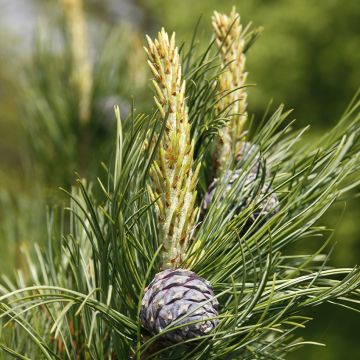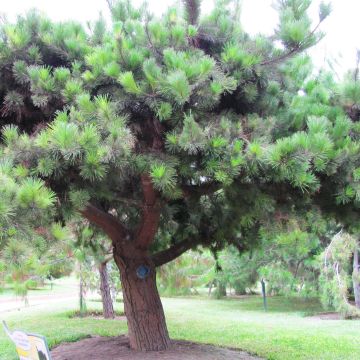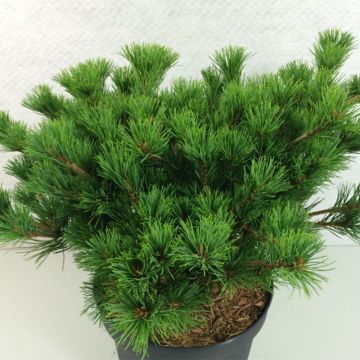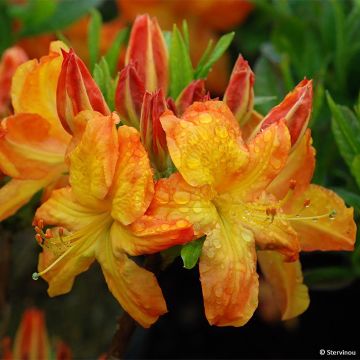

Dwarf Black Pine - Pinus nigra Nana
Dwarf Black Pine - Pinus nigra Nana
Pinus nigra Nana
Black Pine, Austrian Pine
Special offer!
Receive a €20 voucher for any order over €90 (excluding delivery costs, credit notes, and plastic-free options)!
1- Add your favorite plants to your cart.
2- Once you have reached €90, confirm your order (you can even choose the delivery date!).
3- As soon as your order is shipped, you will receive an email containing your voucher code, valid for 3 months (90 days).
Your voucher is unique and can only be used once, for any order with a minimum value of €20, excluding delivery costs.
Can be combined with other current offers, non-divisible and non-refundable.
Home or relay delivery (depending on size and destination)
Schedule delivery date,
and select date in basket
This plant carries a 24 months recovery warranty
More information
We guarantee the quality of our plants for a full growing cycle, and will replace at our expense any plant that fails to recover under normal climatic and planting conditions.
Would this plant suit my garden?
Set up your Plantfit profile →
Description
The Pinus nigra 'Nana' is a dwarf form of Austrian black pine perfectly suited to small spaces, rock gardens, and container gardening. With its naturally compact, rounded, regular habit, and dense foliage, it is a decorative conifer all year round. It requires very little maintenance, except for pruning in late winter. It is also a cold-resistant, drought-tolerant, and low-demanding plant in terms of soil. Plant it as a specimen or combine it with other conifers with different habits, colours, and textures.
The Pinus nigra, also known as Austrian black pine or simply black pine, is an evergreen conifer in the pine family, native to central and southern Europe, from Spain to Crimea, as well as in Asia Minor, Cyprus, and sporadically in the Atlas Mountains. In its natural habitat, it reaches or exceeds 35m (114.8ft) in height, with an open conical shape and a dense crown. It is a highly hardy species, well adapted to hot temperate climates and very chalky or clayey soils. It has good resistance to summer drought.
The 'Nana' variety has been planted and known since before 1855. It is distinguished by its very compact and slow growth. Its overall habit is conical and rounded, forming a ball. During the first years of cultivation, its growth is very slow, so it will only reach a height and width of 1.50m (3.3ft) by 10 years. Pruning the branches by half in late winter helps to enhance its dense appearance and limit its growth. Once well established, it grows about 30cm (11.8in) per year, reaching a mature height of 2.50m (6.6ft) to 3m (9.8ft) with a diameter of 2m (6.5ft). Its tightly packed ascending, whorled branches are covered with dark green, slender needles, 10cm (3.9 in) long, grouped in pairs and arranged in brushes, giving the foliage a slightly feathery appearance. On its trunk, the bark is brown-grey, covered with large flat scales surrounded by deep fissures that widen over the years.
The 'Nana' black pine will work well in a small or medium-sized garden, as a specimen, in a large rock garden, or as a hedge, planted in groups of three near an entrance, or on the edge of a woodland. It can also be grown in a large container for several years. It can planted at the edge of a grove, or its elegant evergreen foliage can be used as a backdrop to highlight flowering plants or the lighter foliage of other dwarf conifers and flowering shrubs. It pairs well with large stones, the geometric lines of pools or buildings, and masonry. It can be combined with complementary grasses or prostrate (Juniperus horizontalis Blue Chip) or globose (Picea abies Little Gem) dwarf conifers. The key is to play with volumes and colours.
Report an error about the product description
Dwarf Black Pine - Pinus nigra Nana in pictures




Plant habit
Foliage
Botanical data
Pinus
nigra
Nana
Pinaceae
Black Pine, Austrian Pine
Cultivar or hybrid
Other Pinus - Pine
View all →Planting and care
The Pinus nigra 'Nana' can be planted from September to November and from February to June in any type of deep soil, even heavy and clayey, very chalky and dry in summer. It only dislikes extremely hot temperatures. However, it requires a sunny exposure to develop well. Soak the root balls well before planting. You can add organic fertiliser to the planting hole. Water thoroughly in the first years, especially during prolonged drought. You can apply a special conifer fertilizer every year in April and cultivate the soil in summer. This very hardy conifer (down to -20°C (-4F) at least) does not need pruning.
Planting period
Intended location
Care
This item has not been reviewed yet - be the first to leave a review about it.
Similar products
Haven't found what you were looking for?
Hardiness is the lowest winter temperature a plant can endure without suffering serious damage or even dying. However, hardiness is affected by location (a sheltered area, such as a patio), protection (winter cover) and soil type (hardiness is improved by well-drained soil).

Photo Sharing Terms & Conditions
In order to encourage gardeners to interact and share their experiences, Promesse de fleurs offers various media enabling content to be uploaded onto its Site - in particular via the ‘Photo sharing’ module.
The User agrees to refrain from:
- Posting any content that is illegal, prejudicial, insulting, racist, inciteful to hatred, revisionist, contrary to public decency, that infringes on privacy or on the privacy rights of third parties, in particular the publicity rights of persons and goods, intellectual property rights, or the right to privacy.
- Submitting content on behalf of a third party;
- Impersonate the identity of a third party and/or publish any personal information about a third party;
In general, the User undertakes to refrain from any unethical behaviour.
All Content (in particular text, comments, files, images, photos, videos, creative works, etc.), which may be subject to property or intellectual property rights, image or other private rights, shall remain the property of the User, subject to the limited rights granted by the terms of the licence granted by Promesse de fleurs as stated below. Users are at liberty to publish or not to publish such Content on the Site, notably via the ‘Photo Sharing’ facility, and accept that this Content shall be made public and freely accessible, notably on the Internet.
Users further acknowledge, undertake to have ,and guarantee that they hold all necessary rights and permissions to publish such material on the Site, in particular with regard to the legislation in force pertaining to any privacy, property, intellectual property, image, or contractual rights, or rights of any other nature. By publishing such Content on the Site, Users acknowledge accepting full liability as publishers of the Content within the meaning of the law, and grant Promesse de fleurs, free of charge, an inclusive, worldwide licence for the said Content for the entire duration of its publication, including all reproduction, representation, up/downloading, displaying, performing, transmission, and storage rights.
Users also grant permission for their name to be linked to the Content and accept that this link may not always be made available.
By engaging in posting material, Users consent to their Content becoming automatically accessible on the Internet, in particular on other sites and/or blogs and/or web pages of the Promesse de fleurs site, including in particular social pages and the Promesse de fleurs catalogue.
Users may secure the removal of entrusted content free of charge by issuing a simple request via our contact form.
The flowering period indicated on our website applies to countries and regions located in USDA zone 8 (France, the United Kingdom, Ireland, the Netherlands, etc.)
It will vary according to where you live:
- In zones 9 to 10 (Italy, Spain, Greece, etc.), flowering will occur about 2 to 4 weeks earlier.
- In zones 6 to 7 (Germany, Poland, Slovenia, and lower mountainous regions), flowering will be delayed by 2 to 3 weeks.
- In zone 5 (Central Europe, Scandinavia), blooming will be delayed by 3 to 5 weeks.
In temperate climates, pruning of spring-flowering shrubs (forsythia, spireas, etc.) should be done just after flowering.
Pruning of summer-flowering shrubs (Indian Lilac, Perovskia, etc.) can be done in winter or spring.
In cold regions as well as with frost-sensitive plants, avoid pruning too early when severe frosts may still occur.
The planting period indicated on our website applies to countries and regions located in USDA zone 8 (France, United Kingdom, Ireland, Netherlands).
It will vary according to where you live:
- In Mediterranean zones (Marseille, Madrid, Milan, etc.), autumn and winter are the best planting periods.
- In continental zones (Strasbourg, Munich, Vienna, etc.), delay planting by 2 to 3 weeks in spring and bring it forward by 2 to 4 weeks in autumn.
- In mountainous regions (the Alps, Pyrenees, Carpathians, etc.), it is best to plant in late spring (May-June) or late summer (August-September).
The harvesting period indicated on our website applies to countries and regions in USDA zone 8 (France, England, Ireland, the Netherlands).
In colder areas (Scandinavia, Poland, Austria...) fruit and vegetable harvests are likely to be delayed by 3-4 weeks.
In warmer areas (Italy, Spain, Greece, etc.), harvesting will probably take place earlier, depending on weather conditions.
The sowing periods indicated on our website apply to countries and regions within USDA Zone 8 (France, UK, Ireland, Netherlands).
In colder areas (Scandinavia, Poland, Austria...), delay any outdoor sowing by 3-4 weeks, or sow under glass.
In warmer climes (Italy, Spain, Greece, etc.), bring outdoor sowing forward by a few weeks.


















































